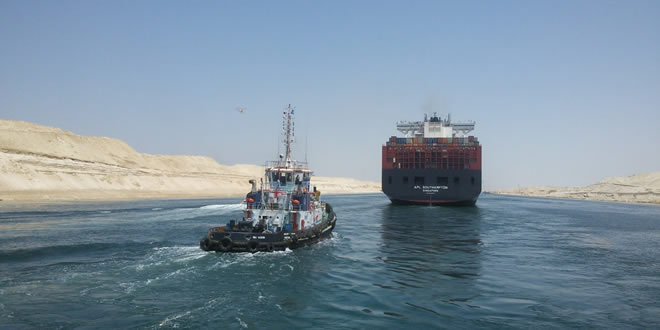Civil Engineering Landmark #2: The Suez Canal
Considered the greatest engineering feat of the nineteenth century, the Suez Canal is one of the most important waterways in the world.Connecting the Mediterranean Sea and the Red Sea, it crosses through the Isthmus of Suez in Egypt. At the time of its construction it was the longest man-made sea level canal in the world. It is also the first man-made canal ever dug in service of world trade. It is one of the world’s most heavily used shipping lanes and separates the African continent from Asia. It provides the shortest maritime route between Europe and the lands lying around the Indian and western Pacific oceans.
History
The idea of building the Suez Canal dates back to several centuries beginning under the reign of Senausret III, Pharaoh of Egypt about 1850 B.C. The canal was often abandoned to silting and various attempts were made to create a functional canal right through the Islamic era. Napoleon Bonaparte kicked off the first modern effort to build the canal. He intended to build a French controlled canal on the Isthmus of Suez that would cause trade problems for the British as they would either have to pay dues to France or continue sending goods over land or around the southern part of Africa. However, a miscalculation estimated that the levels between the Mediterranean Sea and the Red Sea were too great and work on the project was terminated. In 1854 Ferdinand de Lesseps, a French diplomat and engineer, managed to convince the Egyptian viceroy, Said Pasha, to support the building of a canal. The Universal Suez Ship Canal Company was formed in 1858 and given the right to begin construction of the canal and operate it for 99 years, after which time, the Egyptian government would take over control of the canal. The company was owned by French and Egyptian interests but in 1875, the British government purchased Egypt’s shares. Work on the Suez Canal officially began on April 25, 1859 and opened ten years later at a cost of $100 million.
Construction
The Suez Canal is a sea level Canal and the height of water level differs slightly. It slices through the desert for much of its length and takes advantage of natural features such as Lake Timsah and the Bitter Lakes. It is one of the world’s biggest and most important sea level canals, with no locks being required. Covered by hard stones and steel sheet piles, the banks of the Canal are protected from erosion against the wash and waves. Mooring bollards run up both sides of the canal at a distance of 125 meters each and kilometric sign posts help locate the position of ships in the waterway.
After establishing a base at Port Said, de Lesseps spent ten years supervising the digging of the canal that involved excavating about 2.6 million cubic feet of material, most of it sand. He also had to devise a way to supply fresh drinking water for the thousands of laborers that were to be employed on the project which entailed digging up a 24 foot deep channel north to south to connect the lakes. Once the ditches were deep enough, steam-powered bucket dredgers were floated into the waterway to deepen the canal. About 20,000 workers began building the 164 kilometer lockless ship canal from Port Said to Suez. It took ten years for the canal to be completed and new laborers were drafted at the rate of 20,000 every ten months from the ranks of the peasantry. Eventually this labor force was gradually replaced with mechanical dredgers and digging equipment. The dredges used were new inventions, designed by one of the contractors working on the project. After digging troughs that had a depth of six feet to twelve feet, water was let in before the steam dredges were floated down the stream, moored along the bank and set to work. The dredges were of two kinds. Couloirs consisted of a long, broad, flat bottomed barge with a huge framework of wood that supported an endless chain of heavy iron buckets. They stood stationary in deep water, dredged the bottom material via a bucket mechanism, and disposed of its contents into a large iron pipe which emptied out onto the bank. The second type was a smaller, movable dredger which also dredged via a bucket mechanism, but which discharged their sediment onto barges for disposal. The large couloirs were preferred in areas where any great mass of earth had to be removed as they could scoop out a greater volume in a shorter time. Where the terrain was particularly hard, more traditional methods were used to widen the canal such as picks and camels. The workshops of Port Said were built during the digging of the canal and were heavily involved in the construction work. Here, the excavation machinery was assembled and the various types of vessels were maintained and repaired from the damage which occurred during their passage through the canal. The Suez Canal was completed in 1869 and the concession was then given to France. Its depth was about 8 meters and the largest ship load that can pass through was 5000 tons.
After it was opened, it had a significant impact on world trade as goods were moved around the world in record time. After purchasing the shares owned by Egyptian interests, the British maintained a defensive force along the Suez Canal Zone. Egyptian nationalists repeatedly demanded that the British evacuate the Suez Canal Zone and in 1954 the two countries signed a seven-year agreement that superseded the 1936 treaty and provided for the gradual withdrawal of all British troops from the area. It remained under the control of two powers until Nasser nationalized it in 1956; it has since been operated by the Suez Canal Authority.
The Suez Canal has been widened and deepened over the years to accommodate all ships other than the largest crude-oil supertankers. It is constantly being dredged and there are plans to get it to a depth of 22 meters. This will allow 82 per cent of the international oil tanker fleet, 99 per cent of the international bulk tonnage fleet and all other types of full cargo capacity vessels will be able to use the Suez Canal. Throughout its life, it has had a massive influence on the design of ship design, accelerating the development of marine machinery. It also plays a crucial role in Egypt’s economy and is a major revenue earner.




